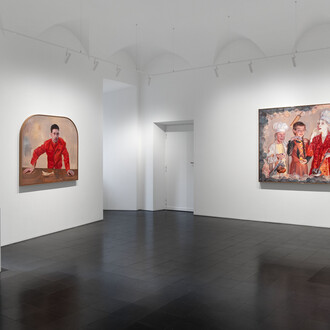Erarta Galleries Saint-Petersburg presents Before and After by Alexander Lufer, an exhibition that combines two of the artist's series - the earlier "Expensive Rugs" and arising from it new one - "Before and After". Without changing his identifiable photorealistic style, the author brought a new focus to his latest series - a game with the concept of "symmetry."
"Symmetry runs through the whole history of art from the ancient times until now. As a resilient matter, it existed before us and, most likely, will exist long time after we are gone.
There is a certain methodology of the symmetry’s impact on visual arts. Leonardo da Vinci’s experiments with reflection and symmetry are well-known; there is also a convincing theory about a secret mirrored code which hides mysterious messages in his works. However, matters of symmetry go back way beyond the times of Leonardo and are originated in ancient ornaments, namely in Neolithic era. Ancient human beings saw symmetry everywhere in nature.
All living beings and organisms are symmetrical. Is it not strange? Symmetry can be viewed as a certain characteristic of life which makes one look for the signs of life even in inanimate objects, such as sculptures and totems.
A human eye is repulsed not only by the obvious anti-symmetry, but also by perfect symmetry. This claim is an easy one to prove - one can take any sculptural imagery, an African mask or Roman portrait, cut it in halves and reflect one half in a mirror. The image will be ideal symmetry-wise but will be increasingly difficult to look at. However, if you reflect the second half right next to the first one, the uneasy feeling will disappear. It is a curious effect: the eye merges the two images in one and perceives it as a whole, like in a diptych.
Contemporaneity brought with it a fast-paced technological development which makes art face a dilemma about acceptance and rejection of high-tech progress in terms of artifact production. In the time both public and professional opinions are in this respect rather conservative; and any technological interference in creative process is considered rule-breaking.
One of the tasks of the series “Before and After” is to overcome the inner resistance of technology which is crucial to creation of symmetrical images. What is perceived as a fault will soon be an asset.
Any artifacts, being separated into two parts, which are consequently self-reflected, obtain an additional dimension in time. It happens because each part carries recognizable features belonging to the whole and consequently turns into an object which went through a certain evolution process.
By means of symmetrical separation a new object, which previously existed only in space, gains a new dimension, namely time. In these works time “appears” in the process of division and the subsequent synthesis.
All points made above shall be considered in order to achieve the ultimate understanding of the series. It is particularly true for a question of time materialization prompted by symmetrical divisions and reflections. It is easily comprehended through the states of past and present or as a barely perceptible moment between before and after." - Alexander Lufer
Erarta Galleries
2, 29th Line, Vasilievsky Ostrov
Saint Petersburg 199106 Russia
Ph. +7 812 3240806
stp@erartagalleries.com
www.erartagalleries.com
Opening hours
Wednesday - Monday
From 10am to 10pm














